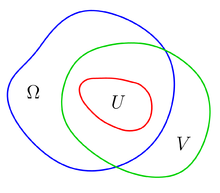- Domain of holomorphy
-
In mathematics, in the theory of functions of several complex variables, a domain of holomorphy is a set which is maximal in the sense that there exists a holomorphic function on this set which cannot be extended to a bigger set.
Formally, an open set Ω in the n-dimensional complex space
 is called a domain of holomorphy if there do not exist non-empty open sets
is called a domain of holomorphy if there do not exist non-empty open sets  and
and  where V is connected,
where V is connected,  and
and  such that for every holomorphic function f on Ω there exists a holomorphic function g on V with f = g on U
such that for every holomorphic function f on Ω there exists a holomorphic function g on V with f = g on UIn the n = 1 case, every open set is a domain of holomorphy: we can define a holomorphic function with zeros accumulating everywhere on the boundary of the domain, which must then be a natural boundary for a domain of definition of its inverse. For
 this is no longer true, as it follows from Hartogs' lemma.
this is no longer true, as it follows from Hartogs' lemma.Contents
Equivalent conditions
For a domain Ω the following conditions are equivalent:
- Ω is a domain of holomorphy
- Ω is holomorphically convex
- Ω is pseudoconvex
- Ω is Levi convex - for every sequence
 of analytic compact surfaces such that
of analytic compact surfaces such that  for some set Γ we have
for some set Γ we have  (
( cannot be "touched from inside" by a sequence of analytic surfaces)
cannot be "touched from inside" by a sequence of analytic surfaces) - Ω has local Levi property - for every point
 there exist a neighbourhood U of x and f holomorphic on
there exist a neighbourhood U of x and f holomorphic on  such that f cannot be extended to any neighbourhood of x
such that f cannot be extended to any neighbourhood of x
Implications
 are standard results. The main difficulty lies in proving
are standard results. The main difficulty lies in proving  , i.e. constructing a global holomoprhic function which admits no extension from non-extendable functions defined only locally. This is called the Levi problem and was first solved by Kiyoshi Oka, and then by Lars Hörmander using methods from functional analysis and partial differential equations (a consequence of -problem).
, i.e. constructing a global holomoprhic function which admits no extension from non-extendable functions defined only locally. This is called the Levi problem and was first solved by Kiyoshi Oka, and then by Lars Hörmander using methods from functional analysis and partial differential equations (a consequence of -problem).Properties
- if Ωn are domains of holomorphy, then their intersection
 is also a domain of holomorphy
is also a domain of holomorphy - if
 is an ascending sequence of domains of holomorphy, then their union
is an ascending sequence of domains of holomorphy, then their union  is also a domain of holomorphy (see Behnke-Stein theorem)
is also a domain of holomorphy (see Behnke-Stein theorem) - product
 of domains of holomorphy Ω1,Ω2 is a domain of holomorphy
of domains of holomorphy Ω1,Ω2 is a domain of holomorphy - the first Cousin problem is always solvable in a domain of holomorphy; this is also true, with additional topological assumptions, for the second Cousin problem
References
- Steven G. Krantz. Function Theory of Several Complex Variables, AMS Chelsea Publishing, Providence, Rhode Island, 1992.
- Boris Vladimirovich Shabat, Introduction to Complex Analysis, AMS, 1992
See also
- Behnke–Stein theorem
- Levi pseudoconvex
- solution of the Levi problem
This article incorporates material from Domain of holomorphy on PlanetMath, which is licensed under the Creative Commons Attribution/Share-Alike License.
Categories:
Wikimedia Foundation. 2010.

